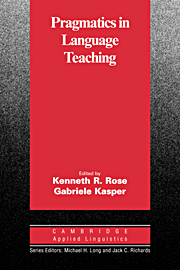Book contents
- Frontmatter
- Contents
- List of contributors
- Series editors' preface
- Preface
- Chapter 1 Pragmatics in language teaching
- I THEORETICAL AND EMPIRICAL BACKGROUND
- II ISSUES IN CLASSROOM-BASED LEARNING OF PRAGMATICS
- III THE EFFECTS OF INSTRUCTION IN PRAGMATICS
- Chapter 7 Acquiring French interactional norms through instruction
- Chapter 8 Inductive and deductive teaching of compliments and compliment responses
- Chapter 9 The role of input enhancement in developing pragmatic competence
- Chapter 10 Explicit and implicit teaching of pragmatic routines: Japanese sumimasen
- Chapter 11 Explicit instruction and JFL learner's use of interactional discourse markers
- IV THE ASSESSMENT OF PRAGMATIC ABILITY
- References
- Name index
- Subject index
Chapter 9 - The role of input enhancement in developing pragmatic competence
Published online by Cambridge University Press: 05 October 2012
- Frontmatter
- Contents
- List of contributors
- Series editors' preface
- Preface
- Chapter 1 Pragmatics in language teaching
- I THEORETICAL AND EMPIRICAL BACKGROUND
- II ISSUES IN CLASSROOM-BASED LEARNING OF PRAGMATICS
- III THE EFFECTS OF INSTRUCTION IN PRAGMATICS
- Chapter 7 Acquiring French interactional norms through instruction
- Chapter 8 Inductive and deductive teaching of compliments and compliment responses
- Chapter 9 The role of input enhancement in developing pragmatic competence
- Chapter 10 Explicit and implicit teaching of pragmatic routines: Japanese sumimasen
- Chapter 11 Explicit instruction and JFL learner's use of interactional discourse markers
- IV THE ASSESSMENT OF PRAGMATIC ABILITY
- References
- Name index
- Subject index
Summary
Introduction
Input enhancement in second language acquisition (SLA) has been addressed in studies of form-focused instruction at morphosyntactic levels, known as Focus on Form (FonF) research (e.g., White, Spada, Lightbown & Ranta, 1991; Carroll, Swain & Roberge, 1992; Fotos, 1993; Spada & Lightbown, 1993; Trahey & White, 1993; see Doughty & Williams, 1998; Long & Robinson, 1998, for an overview). Following Sharwood Smith's (1991, 1993) definition of input enhancement, researchers experimentally manipulated instructional input on L2 structures in various ways: some form of corrective feedback with or without metalinguistic information (e.g., Doughty & Varela, 1998), visual enhancement (textual modification) with the use of bold or italic face (e.g., Alanen, 1995; Jourdenais, Ota, Stauffer, Boyson, & Doughty, 1995; J. White, 1998), and task manipulation directing learners to notice and attend to target structures (e.g., Hulstijn, 1989; Robinson, 1996; Williams & Evans, 1998). All of these studies provided evidence that high levels of attention-drawing activities, as represented by presenting metalinguistic information and corrective feedback, are more helpful for learners in gaining the mastery of target-language structures than simple exposure to positive evidence. These findings thus provide the basis for theoretical verification of Schmidt's (1993a, 1995, 1998) Noticing Hypothesis, which states that conscious noticing is the necessary and sufficient condition for converting input to intake. In contrast to the rich array of input enhancement research into morphosyntactic features, there have been considerably fewer studies specifically focusing on the role of input enhancement in developing L2 pragmatic competence.
- Type
- Chapter
- Information
- Pragmatics in Language Teaching , pp. 171 - 199Publisher: Cambridge University PressPrint publication year: 2001
- 90
- Cited by

